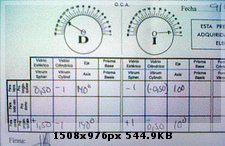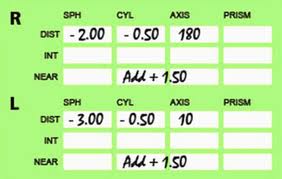Prescription or Ophtalmological Recipe
It is very easy to get to know your prescription with a recipe. Normally, if you go to the optic or the ophtalmologist he will give you your prescription in a paper that we call Optical Prescription or recipe.
On the recipe, you will firstly see your right eye prescription and then normally, the left eyes.


Farsightedness
On the recipe it will appear as far, far seeing, for every use, VL, Sphere, SPh. It indicates us the prescriptions sphere that you need, it can be of myopia so it will be preceded by a "-" symbol (example:-2.00 esf, -2.00 Dp) or it can also be farsightedness so it will come with a "+" symbol (ej: +2.00 esf, +2.00 Dp) or without a symbol at all (example: 2.00). This long sight value or far sight sphere is a number followed by two decimal numbers, that add up from 0,25 to 0,25 as this example (-1.00,-1.25, -1.50, -1.75, -2.00).
Astigmatism / Cylinder
If you have astigmatism, it will appear as CIL, Cylinder on the recipe, and then eje, axis. This astigmatism is always associated to an axis, therefore there will always appear a number with a sign like "+"or "-" with two decimal numbers next to the axis, that will be a number between 0º and 180º (it normally goes from 5 to 5) (ej: +2.00 cil to 90º, or -2.00 cil to 180º). On the recipe, a circle or a semi circle might also appear, where the professional optic must indicate the axis with a line that goes from the centre of the circle to the axis value.
Addition
near, for near, esf cerca, VP. We must add this value or header if you want to make a progressive lens or for only reading glasses.
In order to put the necessary close or near prescription to a progressive, we must know which is the Addition (Add). This value indicates us the power that we must add to your far sphere so that you are able to see well in close distances. It is a positive value "+" and worth usually fluctuates between +0,75 and +3.00Dp, increasing 0,25 each time depending on the age. If it comes as Add, we will insert it on the Addition header for the progressive prescription. If it comes as Near or Close Vision or VP Near we must calculate it´s, as follows. To calculate your addition we must deduct (take off) the long distance prescription from the close or near distance one.
If you have farsightedness we must deduct from the near sight prescription as follows:
(VC +3.00) - ( VL+1.00), Add Addition will be +2.00 (3-1)
If you have myopia we must do an algebraic subtraction, counting with the symbols "+" and "-".
(VC +2.00) - (VL -1.00) Add Addition will be +3.00 (+2.00 +1.00)
(VC -3.00) - (VP-5.00) Add Addition will be +2.00 (-3.00 + 5.00).
It´s easy, we only need to know the difference between close and far distance prescriptions.
Inter Pupillary Distance
Put a rigid rule to the height of the eyebrows. The ruler must be straight, parallel to your eyes, not tilted.
You have to have open eyes without glasses.Ask someone to take a picture of you with a digital camera. You have to get to about 3 meters in front in front of the camera and it can't be tilted .You have to look at the camera lens, and remember in front of it. It is better to put the flash (even if light).Do not cover the rule because we can not do the operation if we can not see the numbers.We need them to focus you in the face, with eyes wide open and the ruler can not be blurred.
And you're done, send the photo to info@opticathome.com giving us your order number and we will mount the glasses with the correct pupillary distance.